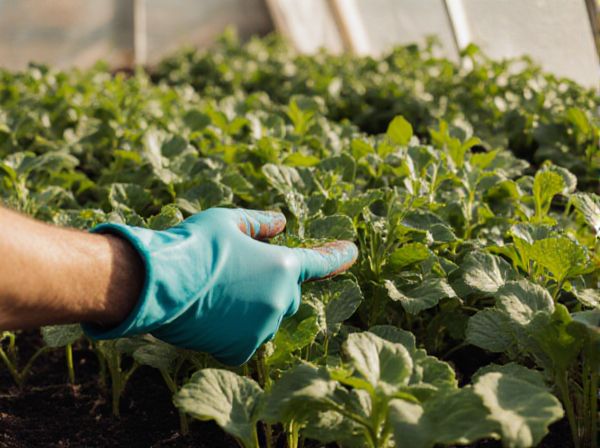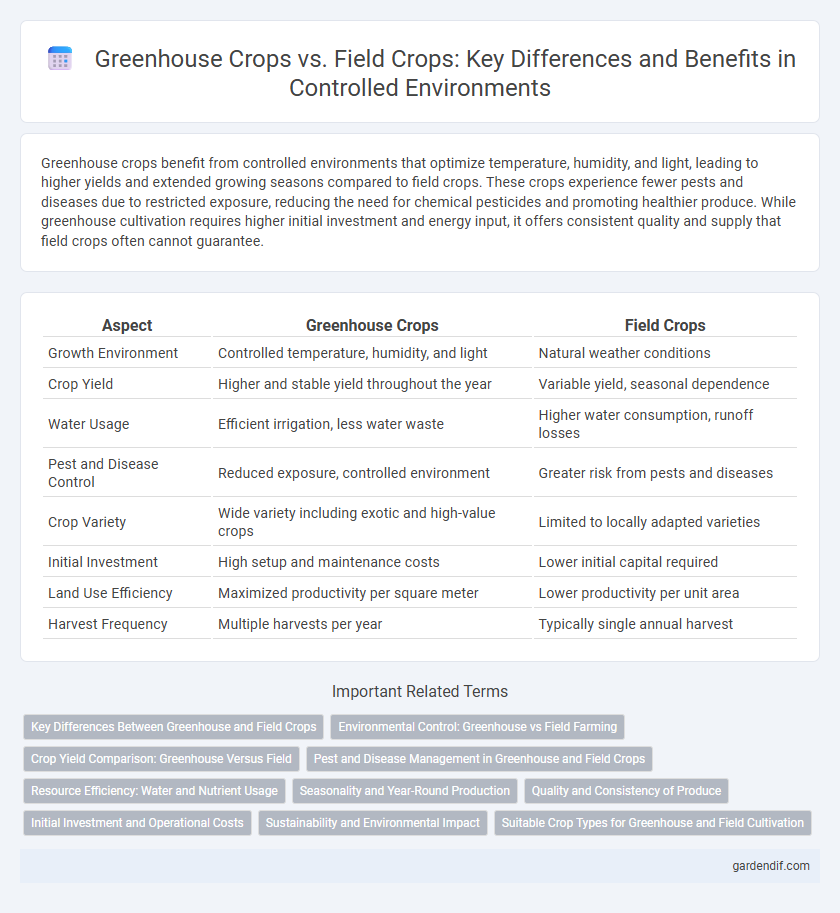
Greenhouse crops vs field crops Illustration
Greenhouse crops benefit from controlled environments that optimize temperature, humidity, and light, leading to higher yields and extended growing seasons compared to field crops. These crops experience fewer pests and diseases due to restricted exposure, reducing the need for chemical pesticides and promoting healthier produce. While greenhouse cultivation requires higher initial investment and energy input, it offers consistent quality and supply that field crops often cannot guarantee.
Table of Comparison
| Aspect | Greenhouse Crops | Field Crops |
|---|---|---|
| Growth Environment | Controlled temperature, humidity, and light | Natural weather conditions |
| Crop Yield | Higher and stable yield throughout the year | Variable yield, seasonal dependence |
| Water Usage | Efficient irrigation, less water waste | Higher water consumption, runoff losses |
| Pest and Disease Control | Reduced exposure, controlled environment | Greater risk from pests and diseases |
| Crop Variety | Wide variety including exotic and high-value crops | Limited to locally adapted varieties |
| Initial Investment | High setup and maintenance costs | Lower initial capital required |
| Land Use Efficiency | Maximized productivity per square meter | Lower productivity per unit area |
| Harvest Frequency | Multiple harvests per year | Typically single annual harvest |
Key Differences Between Greenhouse and Field Crops
Greenhouse crops benefit from controlled environmental conditions, allowing for year-round production, enhanced pest management, and higher yields compared to field crops, which are subject to seasonal and weather variability. Field crops rely heavily on natural sunlight, rainfall, and soil conditions, making them more vulnerable to pests, diseases, and climate fluctuations. The controlled environment in greenhouses enables precise regulation of temperature, humidity, and CO2 levels, optimizing crop growth and resource use efficiency that field cultivation often cannot achieve.
Environmental Control: Greenhouse vs Field Farming
Greenhouse farming offers precise environmental control through regulated temperature, humidity, and light, enabling year-round crop production regardless of external weather conditions. In contrast, field crops depend on natural climate variations, resulting in seasonal limitations and greater vulnerability to extreme weather events. Controlled environments in greenhouses reduce water usage and pesticide application, promoting sustainable agriculture compared to open-field farming.
Crop Yield Comparison: Greenhouse Versus Field
Greenhouse crops typically achieve higher yields compared to field crops due to controlled environmental conditions such as temperature, humidity, and light, which optimize plant growth and reduce stress factors. In greenhouses, the ability to extend growing seasons and protect plants from pests and adverse weather leads to significantly increased productivity per square meter. Field crops, exposed to variable climate and soil conditions, generally have lower and less consistent yields, making greenhouses a preferred option for maximizing crop output in limited space.
Pest and Disease Management in Greenhouse and Field Crops
Greenhouse crops benefit from controlled environments that reduce exposure to many pests and diseases common in open fields, enabling more targeted and efficient pest and disease management strategies. Field crops often face higher pest pressure and disease incidence due to fluctuating weather conditions and lack of physical barriers, requiring broader spectrum applications of pesticides and integrated pest management practices. Effective management in greenhouses relies on preventive measures like biological controls and environmental monitoring, while field crops demand resilient crop varieties and timely interventions to mitigate pest and disease outbreaks.
Resource Efficiency: Water and Nutrient Usage
Greenhouse crops demonstrate superior resource efficiency compared to field crops by utilizing advanced irrigation systems such as drip and hydroponic technologies, which reduce water consumption by up to 90%. Nutrient delivery in greenhouses is precisely controlled, minimizing waste and runoff through closed-loop systems that recycle nutrients. These practices enhance crop yield per unit of water and fertilizer, making greenhouse cultivation a sustainable alternative to traditional field farming.
Seasonality and Year-Round Production
Greenhouse crops offer significant advantages over field crops by enabling year-round production regardless of external weather conditions, effectively bypassing traditional seasonality constraints. Controlled environments within greenhouses allow precise regulation of temperature, humidity, and light, fostering continuous crop growth and higher yields. This consistent production cycle supports market demand throughout the year, reduces supply fluctuations, and enhances food security compared to seasonal field cropping.
Quality and Consistency of Produce
Greenhouse crops consistently exhibit superior quality due to controlled environmental conditions, which minimize pests and diseases and optimize nutrient delivery. This controlled environment ensures uniform growth, resulting in consistent size, color, and flavor compared to field crops exposed to variable weather and soil conditions. Enhanced quality standards in greenhouse production lead to higher market value and improved consumer satisfaction.
Initial Investment and Operational Costs
Greenhouse crops require a higher initial investment due to the cost of specialized structures, climate control systems, and irrigation technology compared to field crops. Operational costs for greenhouse farming include energy expenses for heating, cooling, and lighting, which are significantly greater than those for traditional field cultivation. However, the controlled environment reduces risks from pests and weather, potentially increasing yield efficiency and crop quality.
Sustainability and Environmental Impact
Greenhouse crops optimize resource use by enabling precise control over water, nutrients, and climate, significantly reducing water consumption and pesticide application compared to traditional field crops. Controlled environments minimize soil degradation and nutrient runoff, resulting in lower greenhouse gas emissions and enhanced biodiversity protection. This sustainable approach supports year-round production, reducing transportation emissions associated with seasonal field crop distribution.
Suitable Crop Types for Greenhouse and Field Cultivation
Greenhouse cultivation excels with high-value, temperature-sensitive crops such as tomatoes, cucumbers, peppers, and leafy greens due to controlled environments that extend growing seasons and optimize yields. Field crops like wheat, corn, soybeans, and potatoes thrive in open-air conditions where natural sunlight and large planting areas allow for large-scale production and lower input costs. Crop selection for greenhouse versus field cultivation depends on factors including climate control ability, crop growth cycle, and market demand for year-round availability.
Greenhouse crops vs field crops Infographic

 gardendif.com
gardendif.com